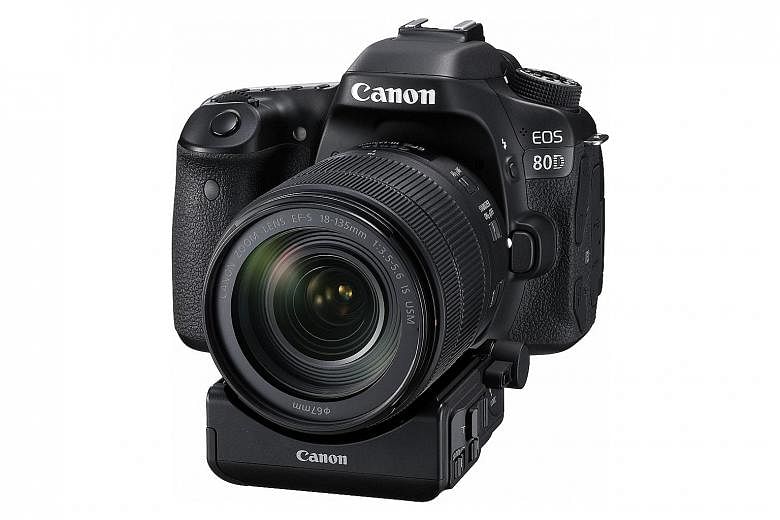The EOS 80D is the mid-range model in Canon's mid-range APS-C DSLR series, sandwiched between the flagship EOS 7D Mark II and entry-level EOS 760D.
It replaces the three-year-old EOS 70D, and features improvements such as a new 24.2-megapixel APS-C CMOS image sensor, Digic 6 image processor and 45-point autofocusing (AF) system. Its predecessor has a 19-point AF system.
The 80D retains its predecessor's Dual Pixel CMOS AF technology, which employs a CMOS sensor that enables all of the effective pixels to perform both imaging functions and phase-detection AF.
Each pixel of the CMOS sensor has two independent photodiodes, or light detectors, that convert light into digital signals.When an image is being captured, both photodiodes combine to deliver a 24.2-megapixel still image.
But when AF is used in Live View image capture and video recording, each photodiode acts as an independent phase-detection AF sensor to help the lens achieve quicker focus.

-
TECH SPECS
-
PRICE: $2,249 (with EF-S18- 135mm f/3.5-5.6 IS USM lens)
IMAGE SENSOR: 24.2-megapixel APS-C CMOS
SCREEN: 3-inch rotatable touchscreen LCD with 1,040,000 dots
SENSITIVITY: ISO 100 - 25,600
SHOOTING SPEED: Up to 7 frames per second
CONNECTIVITY: Wi-Fi
WEIGHT: 730g (body only, with battery and memory card)
-
RATING
-
FEATURES: 4/5
DESIGN: 4/5
PERFORMANCE: 5/5
BATTERY LIFE: 5/5
VALUE FOR MONEY: 4/5
OVERALL: 4/5
The review unit comes with Canon's new EF-S18-135mm f/3.5-5.6 IS USM lens. This is the first lens to feature Canon's new Nano USM focusing motor, which combines the fast still image AF of Canon's USM (ultrasonic motor) lenses with the smooth quiet video recording AF of Canon's STM (stepping motor) lenses.
This lens is also compatible with the new Power Zoom Adapter PZ-E1 (pricing to be confirmed, available this month). Powered by four AA batteries, the PZ-E1 attaches to the Nano USM lens' bottom. It allows users to switch between manual and power zoom, as well as toggling between slow and fast zoom. Zoom speed can be adjusted to 10 levels of incremental speeds. This is ideal for videographers who need to slowly zoom into a subject.
Comparing AF speed in Live View mode between EOS 80D and my own workhorse, the EOS 7D, using the same lens, I found that the 7D takes 4sec to focus on a partially lit object, compared to the almost immediate focus achieved by the 80D.
During video recording, the 80D's AF automatically gets a sharp focus in under 2sec (at times, it was only 1sec) when you pan to a new scene. With 7D, you must press the AF button for it to get a sharp focus and, even then, it can take up to 5sec.
Furthermore with the PZ-E1 attached, you can even get the cinematic style of slow zoom into a subject and trust the camera to pick a sharp focus on the subject.
Video quality is stellar with sharp rendition of details and great audio pickup. You can hardly hear the sound of the lens' AF or its powered zoom. But there is no 4K video recording, which is 80D's Achilles' heel.
For still images, the AF in bright sunlight is immediate when shooting through the optical viewfinder. And even in dim conditions, it takes only 1sec to lock onto a focus when it might take double the time for the 7D.
Still images look fantastic with sharp rendition of pixels and details. Colours tend to be neutral, but that can be easily fixed with a bit of processing.
The still image noise performance is average. At ISO 3,200, you start to notice loss in details but images are still usable. ISO 6,400 is probably the highest sensitivity I would recommend if you want to use the picture for print.
This camera's operation is swift. Start-up and shutdown are immediate, with shutter lag virtually non-existent.
Using an SD card with a writing speed of 30MB, the 80D was able to capture 17 RAW images in 2.3sec before the buffer ran out. Pretty much the same as advertised.
Battery life is superb at around 960 still images before you need to change or charge the battery.
However, its build quality is not as solid as the 7D or 7D Mark II. But the 80D's rubberised grip still allows for a good grasp of the camera.
Button layout is also logical, and anyone who knows how to handle a camera will find the many controls and buttons within easy reach.
But there is still no mini-joystick at the rear - found in 7D - that lets you adjust AF point quickly.
With the 80D, changing the AF point is still a two-step process of pressing the AF point button and then turning the command dial to change AF point.
• Verdict: Simply put, the Canon EOS 80D coupled with the EF-S18-135 mm f/3.5-5.6 IS USM kit lens and Power Zoom Adapter PZ-E1 is an affordable but highly capable videographer's DSLR setup.


